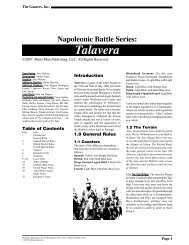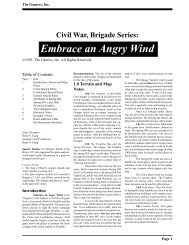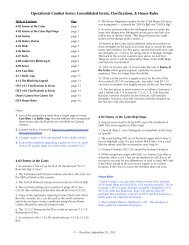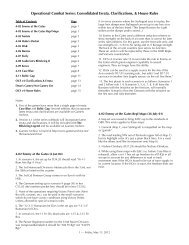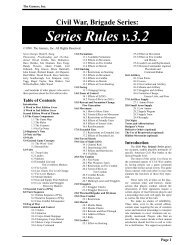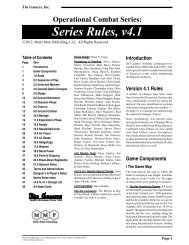The <strong>Gamers</strong>, Inc.5.6 Historical LossesUnit 31 May 1 June Total1-1-2 - 6 62-1-2 - - -3-1-2 - 2 21-2-2 2 - 22-2-2 - - -3-2-2 1 - 11-2-3 - - -2-2-3 1 - 13-2-3 - 1 11-3-3 4 - 42-3-3 - 2 23-3-3 5 - 51-1-4 4 - 42-1-4 6 - 63-1-4 2 - 21-2-4 6 - 62-2-4 4 - 43-2-4 4 - 4Total 39 11 50Unit 31 May 1 June TotalA-L-R 4 - 4C-L-R - - -K-L-R - - -P-L-R - 4 4Pr-L-R - - -W-L-R 1 - 1F-dH-R 9 - 9G-dH-R 7 - 7Ro-dH-R 11 - 11Rs-dH-R 4 - 4Hd-S-L - - -Hm-S-L 3 - 3Ht-S-L 3 - 3L-S-L 3 - 3P-S-L 4 - 4A-Hu - 4 4B-Hu - - -M-Hu - 4 4Total 49 12 61Bibliograhical NotePlease see the Savage Station Rulebook. Thebibliography there covers both battles.Historical Notes<strong>Seven</strong> <strong>Pines</strong> may bear the distinction of being themost mis-managed battle of the entire American CivilWar. While many battles did not go as planned, fewcame apart so completely as did Joseph E. Johnston’s inhis first offensive effort. The result was a confused clashin the woods and fields east of Richmond, and bitterrecriminations afterwards.The battle itself was intended to be Johnston’ssupreme effort to drive the Union invaders from the verygates of the Confederate Capitol, since the Rebel armyhad simply run out of room to do anything else. Johnstonhad been retreating all spring, retiring first from his exposed position aroundManassas to positions near Fredericksburg (and incidentally disruptingUnion General George B. McClellan’s first plan to outflank the Rebels vianaval movement: a planned debarkation at Urbanna, Virginia) and then, onceMcClellan landed on the Peninsula, hurrying south to join ConfederateGeneral John B. Magruder’s small command in opposing the might of theUnion Army of the Potomac in front of Yorktown. Finally, after a month ofinaction and waiting on the Yorktown line, Johnston retreated again, fallingback up the length of the Peninsula towards Richmond.Three months of retrograde action only worsened the tension betweenJohnston and Confederate President Jefferson Davis, tension that had initiallydeveloped over a rank and seniority dispute between the two men thatprevious winter. Now, with Johnston getting ever closer to Richmond, andwith McClellan looming behind him, Davis was losing confidence thatJohnston would ever put up a serious fight to save the city.This distrust on Davis’ part was partially unfair, because Johnston wasclearly handicapped by numbers. The Union army was over 100,000 menstrong, while Johnston’s command was closer to 55,000 troops, a hugedisadvantage to face, especially offensively. A month later, during the morefamous <strong>Seven</strong> Days’ fighting, Davis gave Robert E. Lee almost numericalparity with the Federals by drawing in reinforcements from the ShenandoahValley, southern Virginia, and North Carolina; Johnston got no suchaugmentation.Still, Johnston was well aware of the impossibility of giving upRichmond without a fight, and was always looking for some chance to strikea portion of McClellan’s huge army on something approaching even odds.By the end of May, Johnston thought he found just such a chance.The Chickahominy River was the agent for that opportunity. TheChickahominy flows generally southeast, starting north of Richmond andsplitting the Peninsula in two before flowing into the James River furthereast, and any approach to Richmond from the Peninsula will at some pointhave to cross this stream. Worse for the Federals, McClellan still expected theUnion First Corps—originally part of his army but retained by Washingtonto provide adequate defenses for the Union Capitol—to march overland fromFredericksburg and join the rest of the Army of the Potomac in front ofRichmond. This meant that McClellan was actually forced to straddle theChickahominy, with the 2nd, 5th and 6th Corps on the north bank, and the 3rdand 4th Corps on the south bank. Realizing that the Federals were vulnerablehere, Johnston decided to strike a blow at the two Union corps south of theriver.On the 28th of May, Johnston and his chief subordinates met to finalizeplans for the attack. Two roads were the best avenues to approach the UnionLines: the Nine-mile Road to the north, and the Williamsburg Stage Road tothe south. Both ran east from the Capitol, with the Nine-mile Road curvingsouth after some miles to intersect with the Williamsburg Road at <strong>Seven</strong><strong>Pines</strong>. Hence, these two routes offered parallel approaches and naturallyconverged on the Union position, making them ideal for Johnston’s plans.Further, the Charles City Road ran southeast, providing a route towards theUnion southern flank.Johnston intended to mass two thirds of his army against the two Federalcorps, using all three roads to facilitate the approach. Here, however,communication broke down badly. Johnston’s orders were both vague andverbal: the lack of anything written not only confused commanders at thetime, but also badly muddied the waters in trying to figure out exactly whatwent wrong afterwards.The crux of the problem lay with General James Longstreet. Johnston’sorders called for Longstreet to have overall initial direction of the approachand battle. Longstreet’s large division was supposed to move up the NineMile Road, join General G. W. Smith’s division, and attack the Union right.General D. H. Hill’s division was to move down the Williamsburg Road andopen the action by attacking the Union center. Finally, Huger’s division wasto move via the Charles City Road and threaten the Union left flank nearWhite Oak Swamp. The signal to Hill’s men to start the attack was the arrivalPage 21
<strong>Seven</strong> <strong>Pines</strong> CWB #12of one of Hill’s brigades—Rodes’—stationed out on the Charles City Road,which was to move out when Huger arrivedin its place.Certainly these orders were rathercomplicated, with the entire movementkeyed to the arrival of Rodes’ command onHill’s front after being replaced by Huger’scolumn. Worse yet, Huger was unclear asto whether he was merely a threat or part ofthe actual attack: Johnston’s orders to himdid not specify. With everything linked insuch a manner, any one mis-step couldbreak the chain of cause and effect, therebyderailing the whole concept.However, alternatives were discussed.Longstreet had a simpler proposal: hiscommand would march straight down theWilliamsburg Road, join Hill, and attack.Once Smith heard that firing, Smith wouldjoin in from his positions on the Nine MileRoad. Huger’s mission was unchanged.Unfortunately, during a further meeting onthe 30th, Johnston rejected this concept,but that must not have been clear inLongstreet’s mind. This, coupled withHuger’s uncertainty as to the exact natureof his own role, meant that two of Johnston’sthree columns were not clear on their rolein the plan.On the morning of the 31st, totalconfusion reigned. Longstreet started offdown the wrong road, still intending tomove down the Williamsburg Road asLongstreet suggested, rather than down theNine Mile Road as Johnston’s plan calledfor. Worse, Longstreet and Huger got intoa bizarre dispute over crossing priorities atGillie’s Creek, a raging torrent from rainsthe night before. The bridge was washedout, and the only crossing was hastily made,with two wagons parked in the middle ofthe flood and a footbridge rigged. DespiteHuger’s need for speed in order to relieveRodes’ brigade out on the Charles CityRoad so his arrival in turn could signal thestart of D. H. Hill’s attack, Longstreetinsisted in crossing his 12,000 men first, inan argument that was ultimately settled byseniority of rank. Once across, Longstreetpromptly halted and let Huger’s men crossand move ahead to proceed down theCharles City Road, wasting further time.All the while, the other commandswaiting impatiently. Johnston was waitingwith Smith’s division on the Nine MileRoad, his anxiety further sharpened by thepresence of Davis himself. Relationsbetween the two were so strained thatdespite several hours in close proximitythey barely spoke, except for Davis’periodic inquiries as to why the delay,which cannot have helped Johnston’s mood.By mid-morning, couriers were sent out tofind Longstreet, one of whom returnedwith word that Longstreet was found on theWilliamsburg Road. Given thatLongstreet’s men had started out near theWilliamsburg Road and would have had totravel on a portion of it anyway to reach theNine Mile Road, Johnston assumed thatthis was in fact happening, and whileLongstreet was late, he was not off course.This proved a fatal assumption, for it meantthat Johnston, still not grasping that theplan was derailed, elected to simply waitmore instead of personally going to seekclarification.Simultaneously, D. H. Hill waswaiting for Rodes to arrive. Being the triggerfor what was supposed to be a dawn attack,naturally Hill grew increasingly worriedand impatient as the day reached Noonwithout either any sign of Rodes or wordfrom Huger. Finally, Hill felt he could waitno more, and sent his three availablebrigades forward into the attack. Rodeswas in fact not far off by this time, andquickly followed the rest of Hill’s divisioninto the fight. At last the battle had opened.As Hill’s men swept forward, theyencountered a Union line no more preparedto receive an attack than the Rebels wereprepared to deliver one. The initial Federalline was held by General Silas Casey’s 2ndDivision of the 4th Corps, Surprised,Casey’s men were swept back, and GeneralKeyes—the Union 4th CorpsCommander—quickly called forreinforcements from the Union 3rd Corps,stationed some distance to the rear.Heintzelman, the Union 3rd Corpscommander, responded rapidly, but it wouldbe some time before the two divisions ofhis corps—under two of the most aggressiveGenerals in the Union army, Hooker andKearney—would arrive to support Casey.Keyes’ other division, under DariusCouch, soon found itself being drawn intoCasey’s fight, and further reinforcementswere needed. McClellan’s response was tosend Sumner’s 2nd Corps south of the riverin support, which proved no mean feat. Thesame flood that had turned Gillie’s Creekinto a torrent and delayed the Rebels sobadly had also swollen the Chickahominyto the point where the available bridges that2nd Corps needed were in danger of beingswept away. Sumner, however, wasadamant concerning his orders, and begancrossing his infantry immediately, ricketybridges or no. While the better part of aninfantry division made it across thatafternoon, almost no artillery did, and theremaining division of Sumner’s corps didnot get across until well after dark. Nonethe less, his immediate response aidedKeyes’ embattled line at a critical time.McClellan, who was feeling ill, nevercrossed to the south bank at any time,despite the manifestly large battle occurringon Keyes’ front.All told, D. H. Hill’s command drovethe Union troops for about a mile, attackingthree distinct battle-lines. Few ofLongstreet’s men even got into the fight—only parts of two brigades were engagedtowards the end of the battle on theWilliamsburg Road.It was not until late afternoon—around4:00 p.m., that Johnston began to get a clearpicture of what had happened. Until then,the sounds of the battle on the Williamsburgroad were muted, and Johnston dismissedthem as long range artillery dueling insteadof a major attack. Not until a belated courierarrived from Longstreet was it apparentthat those sounds were the main attack, andthe Rebels there had been fighting forseveral hours.At that point, Johnston ordered G. W.Smith to commit his division, originallyintended to be the reserve for Longstreetalong the Nine Mile Road. Thus, it wascloser to 5:00 p.m. before the lead elementsof this column, under General ChaseWhiting, advanced to attack the Unionlines. Whiting’s men ran into the newlyarrived elements of the Federal SecondCorps who had filed in to replace Couch’sdivision, and despite several furiouscharges, got nowhere.Clearly the result was disappointing.Johnston had intended to use 22 brigades ina concentrated attack on 6 Federal brigades:instead only 10 Confederate brigades evensaw action, and their piecemealcommitment allowed Union reinforcementsto intervene significantly, saving the Federal4th Corps from a disaster. Finally, almostthe last casualty of the day was perhaps themost disruptive at all: Johnston himselfwas wounded observing the fighting alongthe Nine Mile Road, and forced to give upcommand to G. W. Smith.Nightfall found Smith newly thrustinto command of a very confused situation,and at one point Smith asked PresidentDavis himself if there was any news fromLongstreet—hardly filling Davis withconfidence in the new commander. Finally,Smith issued orders for a renewal of theattack the next morning, per Johnston’sintentions. The plan as conceived was notreally sound: Longstreet and Hill were torenew the attack at dawn, driving northinstead of east this time, while Whiting’scolumn was to attack south along the NineMile Road once Longstreet’s attack wasPage 22



